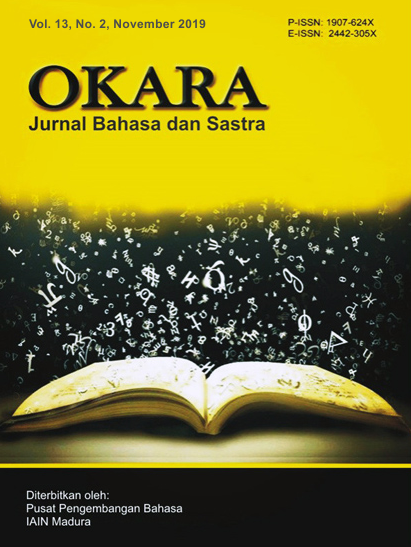Implementation of Blended Learning through Youtube Media to Improve Students’ Speaking Skill
 Abstract views: 2406
,
Abstract views: 2406
,
 PDF downloads: 1526
PDF downloads: 1526
Abstract
With new technology and the way students learn, a vlog is one way to improve students' speaking skills. This research focuses on speaking skill via vlog to improve students' speaking and creativity skills and analyze the interrelationship between the implementation of blended learning and an increase in student self-confidence. This research used mixed methods. The subjects were 13 vlogs made by students on the topic of tourism. The 13 Vlogs are assessed using the rubric developed by Dan Rooney and Elijah Punzalan. The results showed that the highest vlog value was 84 and the lowest was 74, which generally increased students' creativity. Common mistakes on average are ways of delivering or introducing introduction and introduction that are still not good, how to give conclusions or provide summaries and finally the accuracy of the grammatical structure used. There is an increase in speaking ability including vocabulary, fluency, pronunciation and intonation sections. It can be seen that there is a ratio of 2.8 points for vocabulary, 7.9 points for fluency, 10.9 points for pronunciation and 2.1 points for intonation. The findings also infer that the application of speaking through blended learning vlogging media YouTube was declared successful and improved students' speaking abilities.
Downloads
References
“A1 2018 Channel.” YouTube. Accessed August 20, 2019. https://www.youtube.com/channel/UC1ajpjgOk6EASFOoi6J13pg.
Albantani, Azkia Muharom, and Ahmad Madkur. “Musyahadat Al Fidyu: Youtube-Based Teaching and Learning of Arabic as Foreign Language (AFL).” Dinamika Ilmu 17, no. 2 (December 31, 2017): 291–308. https://doi.org/10.21093/di.v17i2.854.
Apriliyanti, Dewi Listia. “The Correlation between EFL Learners’ Motivation on English Course and Their English Learning Achievement.” TARBIYA: Journal of Education in Muslim Society 4, no. 2 (December 21, 2017): 232–39. https://doi.org/10.15408/tjems.v4i2.6401.
Caraivan, Luiza. “Blended Learning: From Concept to Implementation.” Euromentor 2, no. 4 (2011): 8.
Clark, Richard E. Learning From Media: Arguments, Analysis, and Evidence. North Carolina: Information Age Publishing, 2001.
Creswell, John W. Research Design: Qualitative, Quantitative, and Mixed Methods Approaches. 3rd ed. California: SAGE Publications Ltd, 2009.
Leng, Bas A. de, Diana H.J.M. Dolmans, H.(Jeroen) H.L.M. Donkers, Arno M.M. Muijtjens, and Cees P.M. van der Vleuten. “Instruments to Explore Blended Learning: Modifying a Method to Analyse Online Communication for the Analysis of Face-to-Face Communication.” Computers & Education 55, no. 2 (September 2010): 644–51. https://doi.org/10.1016/j.compedu.2010.02.024.
Liao, Y. L. “A Comparative Study of Responses of Teachers and Students in Middle Schools to a Cyber Fair Program,” Vol. 2. Taiwan: Kuan Tang International Publications, 2006.
Maharani, Suesthi. “The Use of Puppet: Shifting Speaking Skill from the Perspective of Students’ Self-Esteem.” REGISTER JOURNAL 9, no. 2 (2016): 17.
Maulidah, Izzah. “Vlog: The Mean to Improve Students’ Speaking Ability.” In Proceedings of the International Conference on English Language Teaching (ICONELT 2017). Surabaya, Indonesia: Atlantis Press, 2018. https://doi.org/10.2991/iconelt-17.2018.3.
Miles, Matthew B., A. M. Huberman, and Johnny Saldaña. Qualitative Data Analysis: A Methods Sourcebook. 3rd ed. Thousand Oaks, Califorinia: SAGE Publications, Inc, 2014.
Muzammil, Lasim, and Andy Andy. “Teaching Proficiency Through Reading and Storytelling (TPRS) as a Technique to Foster Students’ Speaking Skill.” JEELS (Journal of English Education and Linguistics Studies) 4, no. 1 (April 7, 2017): 19–36. https://doi.org/10.30762/jeels.v4i1.329.
Namaghi, Seyyed Ali Ostovar, Seyyed Esmaail Safaee, and Abdolreza Sobhanifar. “The Effect of Shyness on English Speaking Scores of Iranian EFL Learners.” Journal of Literature, Language and Linguistics 12 (2015): 22–28.
Punzalan, Elijah. “Rubric for Vlog | Multimedia | Graphics.” Scribd. Accessed July 22, 2019. https://www.scribd.com/document/362355965/Rubric-for-Vlog.
Rooney, Dan. Public Speaking and Oral Presentation Component. Accessed July 22, 2019. https://www.pccua.edu/images/uploads/content_files/Speech_Rubric_Revised.doc.
Rovai, Alfred P., and Hope M. Jordan. “Blended Learning and Sense of Community: A Comparative Analysis with Traditional and Fully Online Graduate Courses.” International Review of Research in Open and Distance Learning 5, no. 2 (2004): 1–13.
Saeheng, Pornpimon. “A Study of E-Learning, Blended Learning, and Traditional Teaching Methods to Motivate Autonomous Learning in English Reading Comprehension of Thais Learners.” IJELTAL (Indonesian Journal of English Language Teaching and Applied Linguistics) 2, no. 1 (October 20, 2017): 1–20. https://doi.org/10.21093/ijeltal.v2i1.36.
So, Hyo-Jeong, and Thomas A. Brush. “Student Perceptions of Collaborative Learning, Social Presence and Satisfaction in a Blended Learning Environment: Relationships and Critical Factors.” Computers & Education 51, no. 1 (August 1, 2008): 318–36. https://doi.org/10.1016/j.compedu.2007.05.009.
Wafi, Abdul. “Eight Keys before Learning to Speak English.” OKARA: Jurnal Bahasa dan Sastra 9, no. 2 (2015): 234–49.
Watson, John. “Blending Learning: The Convergence of Online and Face-to-Face Education.” NACOL: North American Council for Online Learning, 2008, 18.
The journal operates an Open Access policy under a Creative Commons Attribution-NonCommercial 4.0 International License. Authors who publish with this journal agree to the following terms:
- Authors retain copyright and grant the journal right of first publication with the work simultaneously licensed under a Creative Commons Attribution License that allows others to share the work with an acknowledgement of the work's authorship and initial publication in this journal.
- Authors are able to enter into separate, additional contractual arrangements for the non-exclusive distribution of the journal's published version of the work (e.g., post it to an institutional repository or publish it in a book), with an acknowledgement of its initial publication in this journal.
- Authors are permitted and encouraged to post their work online (e.g., in institutional repositories or on their website) prior to and during the submission process, as it can lead to productive exchanges, as well as earlier and greater citation of published work.





_(1).png)
.png)
.png)
1.png)
.png)
.png)

.png)
_-_Copy_-_Copy.png)





